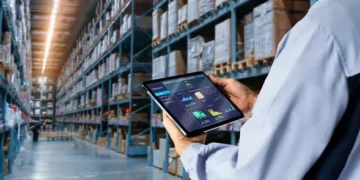Food chain traceability plays a vital role in understanding how various elements, including materials, packaging, products, and processing aids, traverse the complex web of the supply chain. It encompasses two essential components: tracking and tracing. Traceability systems are the backbone of initiatives related to food safety, quality, sustainability claims, and measures to prevent food fraud and food defense incidents.
Tracing involves retracing a product’s journey from the retail shelf back to the manufacturer, their ingredient suppliers, and the suppliers of those suppliers. Tracking, on the other hand, entails following the journey of materials, like spices, from their source to the final products that incorporate these materials. The level of detail in traceability, often referred to as granularity, is a crucial aspect. It determines how finely we can trace a product, considering factors such as the time element, which could span a week, a day, or a single production shift. Additionally, granularity takes into account the geographical scope, ranging from the “one step forward, one step back” (SFSB) approach to the comprehensive “field to fork” (F2F) traceability. These traceability aspects play a pivotal role in information sharing within supply chains and affect the characteristics of the data and systems involved. Key attributes discussed in this article include visibility, transparency, and trust.
Drivers of Global Traceability Figure 1 presents a comprehensive overview of the numerous drivers influencing traceability in today’s global food supply chains. Notably, the GS1 standards organization has been instrumental in promoting product traceability and recalls across various segments of the food industry. GS1’s Traceability Standard is a valuable resource for organizations, offering implementation guidance for sectors such as beef, fish, poultry, pork, fresh produce, eggs, wine, and more. The standard also addresses the evolving need for organizations to grasp critical tracking events (CTEs) and key data elements (KDEs). For instance, the recent U.S. Food and Drug Administration (FDA) Final Food Traceability Rule emphasizes the necessity of CTEs and KDEs for specific products, with full compliance set for January 20, 2026. This final rule is a significant part of the FDA’s New Era of Smarter Food Safety blueprint and aligns with Section 204(d) of the FDA Food Safety Modernization Act (FSMA).
Food Traceability and Privacy Considerations Our comprehension of food traceability has expanded significantly over the past two decades. As with any emerging field, it continues to evolve and mature, with various interpretations and practical applications. The application of traceability varies, and although it is progressing, several challenges remain. Field-to-fork (F2F) traceability is a frequent topic of discussion and has been achieved in certain supply chains using analog, paper-based systems. Transitioning to digital traceability approaches is proposed, but it poses challenges in terms of aggregating and openly sharing information across supply chains (supply chain visibility).
One area where digital traceability systems have profound public health implications is allergen management. However, a less-discussed aspect of F2F traceability is privacy laws, which safeguard consumer transactions from being tracked without explicit consent. The issue of privacy arises when contemplating the extent to which organizations or government agencies should monitor food purchases and consumption within households. The use of customer loyalty cards, which offer rewards in exchange for purchase information, and online shopping features like “your shopping list” are familiar practices. However, these data-driven loyalty programs and online algorithms provide only a partial view of food purchases, waste, and consumption within households, leaving the question of consumer privacy a topic of consideration.
Catch the latest in supply chain news on The Supply Chain Report. Visit ADAMftd.com for free international trade tools.
#FoodChainTraceability #SupplyChainTransparency #FoodSafety #Sustainability #TraceabilitySystems #GlobalSupplyChains #GS1Standards #FDATraceabilityRule #GranularityInTraceability #FieldToFork #FoodFraudPrevention #PrivacyInFoodTraceability #DigitalTraceability #AllergenManagement #ConsumerPrivacy #SmartFoodSafety #TraceabilityInFood #VisibilityInSupplyChain #SupplyChainTracking #SupplyChainData #FoodSupplyChainVisibility #FoodQualityAssurance #TransparencyInFoodIndustry #FoodDefense #SupplyChainTrust

















